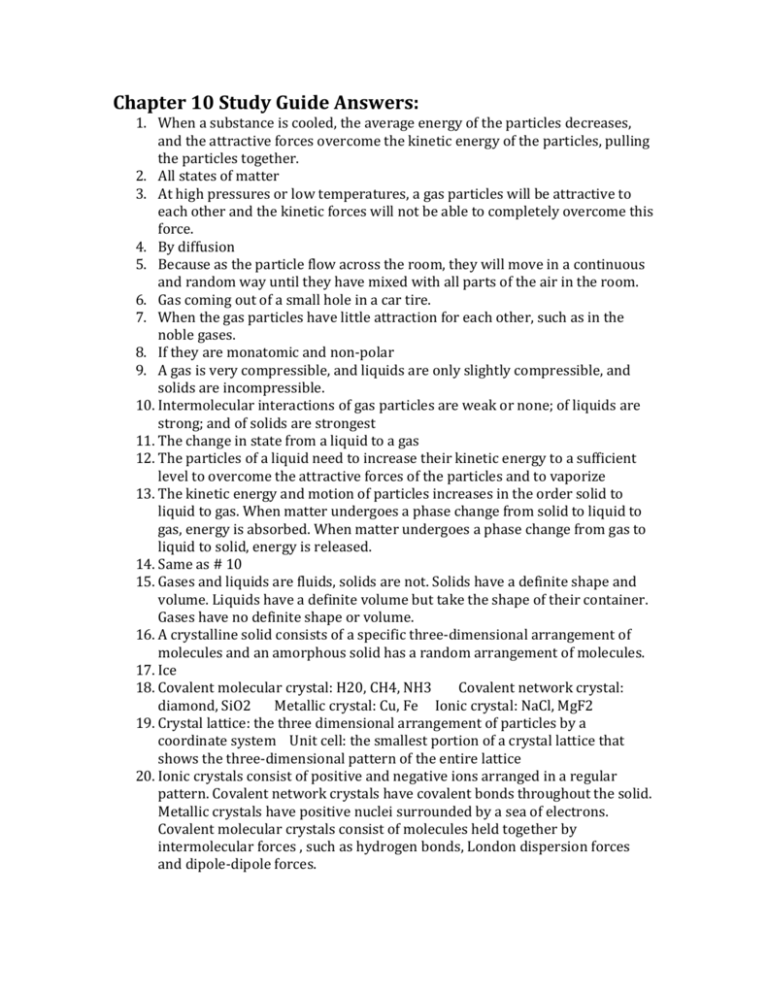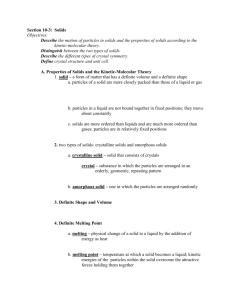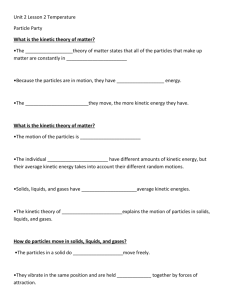File
advertisement

Chapter 10 Study Guide Answers: 1. When a substance is cooled, the average energy of the particles decreases, and the attractive forces overcome the kinetic energy of the particles, pulling the particles together. 2. All states of matter 3. At high pressures or low temperatures, a gas particles will be attractive to each other and the kinetic forces will not be able to completely overcome this force. 4. By diffusion 5. Because as the particle flow across the room, they will move in a continuous and random way until they have mixed with all parts of the air in the room. 6. Gas coming out of a small hole in a car tire. 7. When the gas particles have little attraction for each other, such as in the noble gases. 8. If they are monatomic and non-polar 9. A gas is very compressible, and liquids are only slightly compressible, and solids are incompressible. 10. Intermolecular interactions of gas particles are weak or none; of liquids are strong; and of solids are strongest 11. The change in state from a liquid to a gas 12. The particles of a liquid need to increase their kinetic energy to a sufficient level to overcome the attractive forces of the particles and to vaporize 13. The kinetic energy and motion of particles increases in the order solid to liquid to gas. When matter undergoes a phase change from solid to liquid to gas, energy is absorbed. When matter undergoes a phase change from gas to liquid to solid, energy is released. 14. Same as # 10 15. Gases and liquids are fluids, solids are not. Solids have a definite shape and volume. Liquids have a definite volume but take the shape of their container. Gases have no definite shape or volume. 16. A crystalline solid consists of a specific three-dimensional arrangement of molecules and an amorphous solid has a random arrangement of molecules. 17. Ice 18. Covalent molecular crystal: H20, CH4, NH3 Covalent network crystal: diamond, SiO2 Metallic crystal: Cu, Fe Ionic crystal: NaCl, MgF2 19. Crystal lattice: the three dimensional arrangement of particles by a coordinate system Unit cell: the smallest portion of a crystal lattice that shows the three-dimensional pattern of the entire lattice 20. Ionic crystals consist of positive and negative ions arranged in a regular pattern. Covalent network crystals have covalent bonds throughout the solid. Metallic crystals have positive nuclei surrounded by a sea of electrons. Covalent molecular crystals consist of molecules held together by intermolecular forces , such as hydrogen bonds, London dispersion forces and dipole-dipole forces. 21. The rate of evaporation varies proportionately to the T, so that a rise in T results in an increase in the rate of evaporation. 22. The molecules need to gain enough kinetic energy to overcome the attractive forces at the surface of the liquid and escape into the vapor phase. 23. No, every liquid has a specific equilibrium vapor pressure 24. The point where a substance can exist in all states of matter simultaneously (gas, liquid and solid) at a specific T and P conditions 25. Critical T: the T above which the substance cannot exist in a liquid state Critical P: the lowest P at which the substance can exist as a liquid at the critical T 26. A liquid which evaporates readily 27. Ether has a high equilibrium vapor pressure because there are very weak forces of attraction between its particles in the liquid state. Molten ionic compounds have a relatively low equilibrium vapor pressure in the liquid state because there are relatively strong forces of attraction between its molecules. 28. Solid to liquid=melting, liquid to solid=freezing, solid to gas=sublimination, gas to solid=deposition, liquid to gas=vaporization, gas to liquid=condensation 29. At pressure greater than 1 atm, water boils at a T higher than 100* C. At a pressure lower than 1 atm, water boils at a T lower than 100* C. This is because the boiling point of any liquid is the point at which its equilibrium vapor pressure equals the atmospheric pressure. 30. The boiling point is slightly higher (35* verses 34.6*) due to the higher atmospheric pressure 31. Liquid water at 0* C











